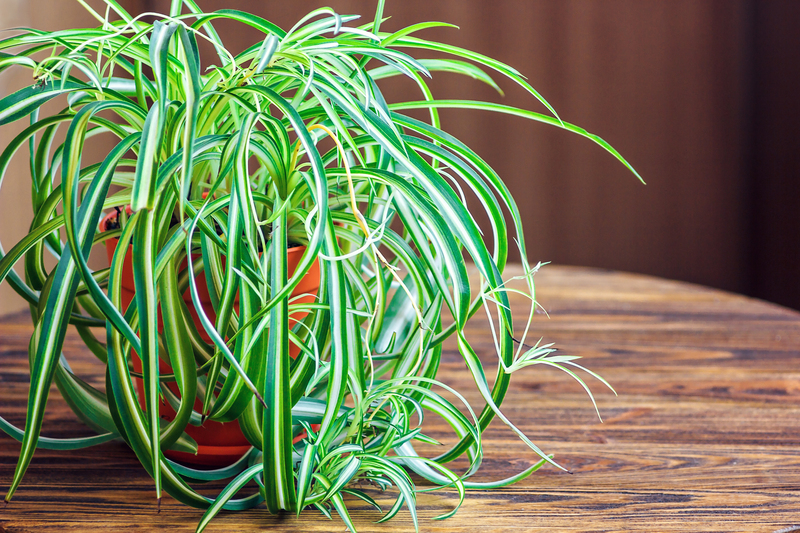Explore Tranquility: Zen Garden Design Ideas for Peace
Posted on 03/09/2025
Explore Tranquility: Zen Garden Design Ideas for Peace
Imagine entering your backyard and immediately feeling a sense of calm, a gentle breeze rustling through slender bamboo, soft stones underfoot, and the gentle trickle of water soothing your mind. Zen gardens, rooted in centuries-old Japanese traditions, are crafted specifically to invite serenity into our lives. If you aspire to infuse peace and mindfulness into your daily routine, designing a Zen-inspired sanctuary may be the answer. In this comprehensive guide, we'll explore tranquility through actionable Zen garden ideas, practical tips, and timeless philosophies that promote inner calm and outdoor beauty.
What Is a Zen Garden and Why Choose It?
A Zen garden--also known as a Japanese rock garden or Karesansui--is a minimalist landscape made up primarily of rocks, gravel, sand, and a sparse use of plants. Originally developed by Buddhist monks as places for meditation, these gardens are designed to represent the essence of nature and inspire meditative reflection.
- Simplicity: Zen gardens eschew clutter, focusing on essential elements to create a clear space for contemplation.
- Symbolism: Every element--from raked gravel symbolizing water to carefully placed stones representing mountains--holds meaning.
- Low Maintenance: With little lawn and few plants, these peaceful spaces require minimal upkeep.
- Timelessness: The design principles are age-old, making Zen garden ideas for peace perennially relevant.
Benefits of Creating a Zen Retreat
- Reduces stress: Less visual noise fosters relaxation and mental clarity.
- Encourages mindfulness: Gardening activities like raking gravel can be meditative.
- Enhances property value: A thoughtfully designed Zen garden appeals to buyers who appreciate unique, tranquil landscapes.
- Connects you with nature: Even small Zen gardens bring the calming presence of outdoors close to home.

Core Elements of Zen Garden Design
The art of Zen garden design is built around a few key components. Let's delve into the main elements that help turn an ordinary yard into a tranquil Zen oasis:
1. Gravel and Sand
Loose sand or fine gravel covers the ground, standing in for water or open space. These surfaces are raked into rippling, flowing patterns, encouraging a meditative state.
- White gravel offers a clean, luminous look and symbolizes purity.
- Fine sand can be used in small courtyards, balancing hard edges with delicate lines.
- Raking daily or weekly transforms the act into a calming ritual.
2. Rocks and Stones
Stones represent islands, mountains, or animals. Their placement should feel both natural and intentional.
- Group stones in odd numbers (such as three, five, or seven) for visual balance.
- Choose a central 'feature stone' as a focal point for reflection.
- Use weathered, smooth rocks for a gentle, aged look.
3. Water Features
While traditional Zen gardens use sand and stones to evoke water, actual water features like a small pond, babbling brook, or stone basin (Tsukubai) can enhance peace and relaxation.
- Listen to the sound: Soft trickling from a fountain or bamboo spout supports mindfulness.
- Simple is best: Keep water features small and unadorned.
4. Minimalist Plantings
Unlike lush English gardens, Zen gardens favor restraint. Choose plants wisely, creating silent harmony.
- Bamboo for vertical accent and gentle movement
- Moss cushions stones and introduces velvety texture
- Evergreens (such as Japanese black pine)
- Maples for seasonal color without overpowering the scene
5. Pathways and Stepping Stones
Stepping stones guide visitors through the garden, symbolizing the journey of life. These pathways invite you to walk slowly, fostering mindfulness.
- Irregularly spaced stones slow your pace and encourage observation.
- Pathways can suggest a meandering stream or mountain trail.
- Edges of the path may be softened with moss or groundcover.
Design Ideas for Zen Gardens: Bringing Serenity Home
Ready to start your tranquil sanctuary? Here are practical Zen garden layout ideas suitable for any yard--large or small:
1. The Courtyard Zen Garden
Maximize a small space by transforming a walled courtyard or patio into a peaceful haven.
- Line the ground with white gravel or sand, bordered by smooth river stones.
- Add a single, sculptural tree--such as a Japanese maple--for shade.
- Use potted bamboo or dwarf conifers for easy maintenance.
- Anchor one corner with a simple stone lantern or water basin.
2. Modern Minimalist Zen Design
Combine Zen tranquility with modern aesthetics for a seamless look.
- Square or rectangular gravel beds, bordered by dark stone or concrete.
- Choose a restrained palette: black, gray, white and green.
- Integrate geometric water features or steel planters.
- Highlight one or two feature stones as sculptural art.
3. Traditional Karesansui Garden
Evoking the timeless spirit of Japanese temple gardens, this layout combines classic symbolism with austere beauty.
- Arrange groups of stones in deliberate, asymmetrical patterns.
- Rake sand into concentric circles around rock clusters.
- Install a bamboo fence as a natural backdrop.
- Use moss and low shrubs to soften edges.
4. Zen Meditation Corner
Dedicate a secluded nook for sitting, reflecting, or practicing yoga.
- Surround a timber or stone bench with soft gravel.
- Frame the area with bamboo screens or latticework for privacy.
- Include a water basin for ritual hand-washing before meditation.
- Choose aromatic plants like Japanese cypress or thyme for subtle scent.
How to Create Your Own Zen Garden: Step-by-Step
Step 1: Choose Your Location
Select a spot that receives moderate sunlight and feels naturally shielded from distractions. It could be a corner of your backyard, a side yard, or even an indoor balcony or terrace for smaller designs.
Step 2: Prepare the Foundation
- Clear the site of existing vegetation and level the ground.
- Lay out landscape fabric to deter weeds and keep your garden clean.
- Add a layer of compacted sand or gravel as a base.
Step 3: Define the Boundaries
Frame your Zen garden with wood, stones, or bamboo fencing. Boundaries enhance the sense of seclusion and highlight the peaceful garden design.
Step 4: Arrange Rocks and Stones
- Start with the largest stones first, choosing their angles and placement carefully.
- Group stones in visually appealing arrangements, maintaining asymmetry and avoiding straight lines.
- Experiment before settling them fully into the ground.
Step 5: Add Sand or Gravel
- Spread your chosen material evenly across the base, keeping it a few inches deep.
- Rake into flowing lines, spirals, or waves as desired. These patterns symbolize water and promote calm.
Step 6: Integrate Plantings and Water Features
- Place minimalist greenery in corners or along the border.
- Add a stone basin, mini waterfall, or fountain to complete the sense of tranquility.
Step 7: Add Decorative Touches
- Consider stone lanterns (Toro) or bamboo ornaments for subtle interest.
- Accent the entrance with a traditional wooden gate (Torii) for authenticity.
Maintenance Tips for Your Tranquil Zen Sanctuary
Unlike lush flower gardens, a Zen space is easy to maintain--letting you focus on peace, not pruning.
- Rake gravel regularly to refresh patterns and clear debris.
- Weed vigilantly to preserve a neat, minimal appearance.
- Trim bamboo and shrubs sparingly to maintain clean lines.
- Clean water features periodically to prevent algae buildup.
Zen Garden Design Philosophy: The Keys to Lasting Peace
The best Zen gardens are more than just landscapes--they're invitations to mindful living. To fully capture Zen principles, consider these essential philosophies:
- Simplicity (Kanso): Eliminate the unnecessary and let natural forms shine.
- Asymmetry (Fukinsei): Avoid perfect symmetry, favoring irregular, organic arrangements.
- Naturality (Shizen): Edit with humility, allowing each stone and plant its natural presence.
- Subtlety (Yugen): Suggest more than you reveal--mystery is key to curiosity and contemplation.
Design your garden to embrace space and silence. Each feature should serve a subtle purpose, guiding the gaze and stilling the mind.

Frequently Asked Questions About Zen Garden Design for Peace
Can You Make a Zen Garden in a Small Space?
Absolutely! Mini Zen gardens for tabletops or balconies require only a shallow tray, small pebbles, and a few artful stones. Even a tiny space can bring tranquility into your daily routine.
What Are the Best Plants for a Zen Garden?
Stick to minimalist, evergreen choices like bamboo, dwarf pines, moss, and ferns. Japanese maples offer seasonal interest; stay away from showy flowers or large, leafy plants that might detract from clean lines.
How Do I Choose the Right Stones?
Visit local garden centers for weathered rocks or river stones. Look for natural, irregular shapes and experiment with groupings before installing. Each stone should feel as though it belongs exactly where it's placed.
Are Zen Gardens Only for Meditation?
While meditation Zen gardens are popular, anyone can enjoy the peace and focus these spaces bring--whether you're reading, journaling, drinking tea, or simply enjoying a quiet moment outdoors.
How Much Does It Cost to Build a Zen Garden?
Costs vary based on size, material, and location. DIY projects can be surprisingly budget-friendly, especially if you use local rocks, simple gravel, and minimal plantings. Hiring a landscape designer for traditional elements will add to the investment but can create a truly authentic sanctuary.
Conclusion: Experience the Lasting Peace of a Zen Garden
By weaving together the principles and practices outlined above, anyone can explore tranquility and bring peace into their living environment. Creating your own Zen garden for serenity isn't about mastering rules--it's about nurturing harmony, mindfulness, and beauty in your own way. Whether you opt for a sweeping outdoor retreat or a modest Zen corner, the simple act of tending to your garden will anchor you in the present moment and enrich every day with quietude.
Ready to begin? Let your Zen garden be not only a space for peace, but a living reflection of your unique journey toward stillness and clarity.
- Find your center: Let each design decision spring from what brings you calm.
- Practice gently: Your garden, like life, will evolve over time--enjoy the process!
- Cherish simplicity: Sometimes, less truly is more satisfying.
Embrace the timeless art of Zen garden design – and let your outdoor space become a sanctuary of peace, balance, and mindfulness.

